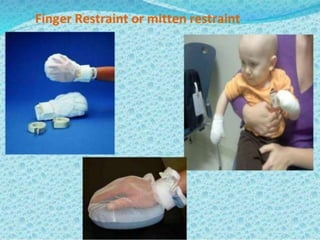Restraints
- 1. RESTRAINTS KALPANA SHEE Msc Tutor S ‘O’A University
- 2. OUT LINE Definition Purpose Indication General Principles Types of restraint Risk and side-effect of restraint use Restraint guideline Role of Nurse
- 3. DEFINITIONS • Restraint is defined as ‘the intentional restriction of a person’s voluntary movement or behavior. (Counsel and Care UK, 2002) • Restraints are physical, chemical or environmental measures used to control the physical or behavioral activity of person or a portion of his/ her body.
- 4. PURPOSE • To carry out the physical examination. • To provide safety. • To protect from injury. • To complete the diagnostic and therapeutic procedures. • To maintain the patient in prescribed position
- 5. INDICATIONS • Displaying behavior that is putting themselves at risk of harm • Displaying behavior that is putting others at risk of harm • Requiring treatment by a legal order, for example , under the Mental Health Act 2007 • Requiring urgent life-saving treatment • Needing to be maintained in secure settings
- 6. GENERAL PRINCPILES • Should be selected to reduce client’s movement only as much as necessary. • Should carefully explain type of restraint and reason for its use. • Should not interfere with treatment. • Bony prominences should be padded before applying it. • Always select the safe and appropriate restraint.
- 7. PRINCIPLES CONTD.. • Restraint should not be too tight; it should not interfere with the normal circulation. • Restraint should demonstrate to gain the cooperation and reduce the anxiety. • Always maintain comfort and maintain body alignment. • Should be changed when they become soiled or damp. • Should be secure away from a clients reach.
- 8. • Should be attached to bed frame not to side rails. • Change the side to prevent pressure sore • Observe the restraint every 20-30 minutes to prevent any complications. • Should be removed a minimum of every 2 hrs. • Do the recording and reporting properly. PRINCIPLES CONTD..
- 10. PHYSICAL RESTRAINT Physical restraint is anything near or on the body which limits a client’s movement. This may be attached to a person’s body or create physical barriers. E.g. table fixed to a chair or a bed rail that cannot be opened by a client
- 11. ENVIORNMENTAL RESTRAINTS Environmental restraints that change or modify a person’s surroundings to restrict or control a client’s mobility E.g. A secure unit or garden, seclusion
- 13. CHEMICAL RESTRAINT Chemical restraint are any form of psychoactive medication used not to treat illness, but to intentionally inhibit a particular behavior or movement.
- 14. TYPES OF PHYSICAL RESTRAINT 1. Mummy restraint 2. Elbow and knee restraint 3. Extremity restraint 4. Abdominal restraint 5. Jacket restraint 6. Mitten or finger restraint 7. Crib net restraint 8. Safety belt 9. Slide rails and splints
- 26. POTENTIAL RISKS AND SIDE EFFECTS OF RESTRAINT USE Psychological /Emotional • Increased agitation & hostility. • Feelings of humiliation, loss of dignity. • Increased confusion. • Fear.
- 27. •Pressure ulcers, skin trauma. •Decreased muscle tone, strength, endurance. •Contractures, loss of balance & Dislocations/ fracture. •Reduced heart and lung capacity. •Physical discomfort, increased pain. •Increased constipation, increased risk of fecal impaction. PHYSICAL:
- 28. •Increased constipation, increased risk of fecal impaction. •Increased incontinence and urinary stasis. •Obstructed and restricted circulation. •Reduced appetite, Dehydration. •Impaired Circulation. •Death. Physical Continue:-
- 29. RESTRAINT GUIDELINES • Use only after written order by the physician, unless emergency situation occurs. • Patient is reassessed every 24 hours for continued need for restraint. • New order is required after 24 hours. • No standing order allowed. • Physician and nurse must document in their notes the indication for restraint. • Type of restraint to be used. • The projected time restraint is to be employed.
- 30. ROLE OF NURSE • Check for circulation, condition of limbs. • Attention should be given to patient’s need including hydration, elimination and nutrition. • Vital signs. • Follows instructions, directions. • Calm, in control.
- 31. • Asks for assistance. • Monitor signs for injury. • Maintain comfort of the patient. • Readiness for discontinuation of restraint. • Release the patient, turn and position frequently. Role of nurse continue…
- 32. • Follow institute a trial of restraint release. • Maintain hydration and nutritional need. • Proper reporting and documentation. Role of nurse continue…

































